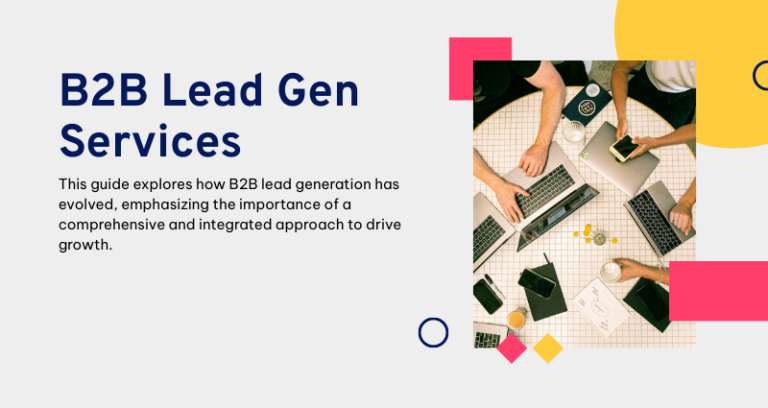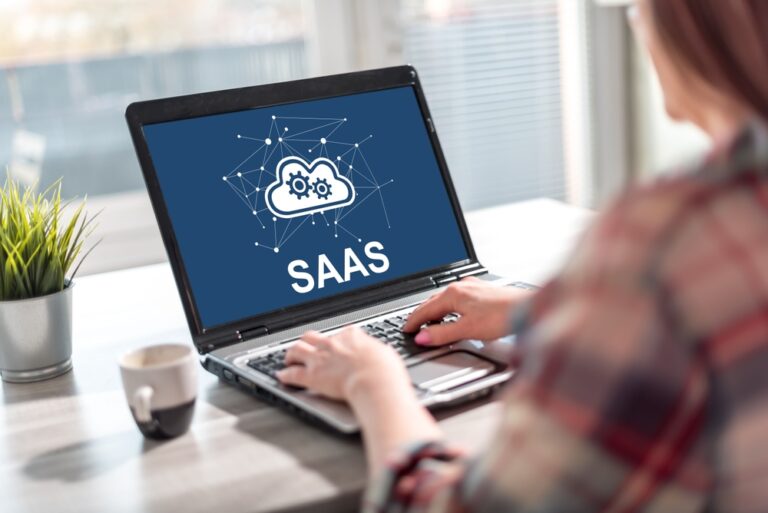Kickstarting Your B2B SaaS Lead Generation Journey
Generating leads in the B2B SaaS space is no small feat, yet it’s the lifeblood of sustainable growth for companies in this sector. A steady influx of qualified leads doesn’t just fuel your sales funnel; it builds a foundation for long-term success by connecting with businesses that genuinely need your solutions. But with shifting buyer behaviors, increasing competition, and evolving technology, capturing attention and building trust requires a well-thought-out approach.
The challenge lies in navigating a complex buyer journey that often involves multiple decision-makers, longer sales cycles, and high expectations for personalization. B2B SaaS companies must combine creativity with data-driven strategies to stand out in this competitive landscape. From leveraging content marketing and SEO to embracing automation tools and account-based strategies, the possibilities for lead generation are vast—but they demand precision and adaptability.
What makes B2B SaaS lead generation particularly exciting is its potential for scalability. Whether you’re targeting niche industries or broader markets, the strategies you employ can be tailored to attract the right leads without wasting resources on unqualified prospects. This focus on efficiency not only improves conversion rates but also fosters better alignment between marketing and sales teams.
By understanding the key stages of the sales funnel, defining an ideal customer profile, and staying ahead of trends, businesses can transform lead generation into a reliable engine for growth. It’s not just about acquiring leads—it’s about building meaningful connections that lead to long-term partnerships. This is the starting point for exploring strategies that truly make an impact in the competitive B2B SaaS landscape.
1. Understanding the B2B SaaS Sales Funnel
Understanding the B2B SaaS sales funnel is the first step toward crafting a lead generation strategy that delivers results. This structured framework illustrates how prospects move from initial awareness to becoming loyal customers. Each stage of the funnel requires a tailored approach to guide leads through their journey effectively, ensuring every interaction aligns with their needs and expectations.
The Top of the Funnel is Where Awareness Begins
The top of the funnel, often referred to as the awareness stage, is where potential customers first encounter your brand. At this point, the audience is not actively searching for your product but is instead exploring solutions to a broader problem. This stage emphasizes visibility and education, making content marketing a critical component.
B2B SaaS companies can utilize blogs, social media posts, and educational videos to address common industry challenges. These resources should aim to provide value without overtly pitching the product. By showcasing expertise and offering actionable insights, businesses can establish credibility and encourage further engagement.
The Middle of the Funnel is About Building Consideration
Once leads are aware of your brand, the focus shifts to the middle of the funnel, the consideration stage. At this point, prospects are evaluating options and beginning to compare solutions. Here, businesses must demonstrate why their offering is the best fit for the lead’s specific needs.
Content such as whitepapers, webinars, and case studies can help solidify a lead’s understanding of how your SaaS product aligns with their objectives. The goal is to nurture these leads with detailed and targeted information, positioning your solution as the most effective option in the market. Personalized follow-ups and engagement are crucial at this stage to build trust and maintain interest.
The Bottom of the Funnel is About Driving Decisions
The bottom of the funnel is where decision-making happens. Leads at this stage are ready to make a purchase but may need additional reassurance. Businesses must focus on converting these prospects into paying customers by addressing potential objections and emphasizing the product’s unique value.
Demonstrations, free trials, and product comparisons are particularly effective tools for closing deals. Offering clear and transparent pricing, showcasing client testimonials, and providing access to support teams can further instill confidence. This is also the time to highlight measurable outcomes, such as time savings, cost reductions, or performance improvements.
Tailoring Strategies for Each Funnel Stage is Key
One of the most important aspects of the B2B SaaS sales funnel is recognizing that one-size-fits-all strategies rarely work. Each stage represents a unique mindset, and successful lead generation depends on meeting prospects where they are. Businesses that segment their messaging and tactics for different stages can significantly improve engagement and conversion rates.
For example, leads at the awareness stage may appreciate broader industry insights, while those in the decision stage require detailed product information. By aligning marketing and sales efforts with the sales funnel, companies can ensure a seamless transition for prospects and a higher likelihood of success.
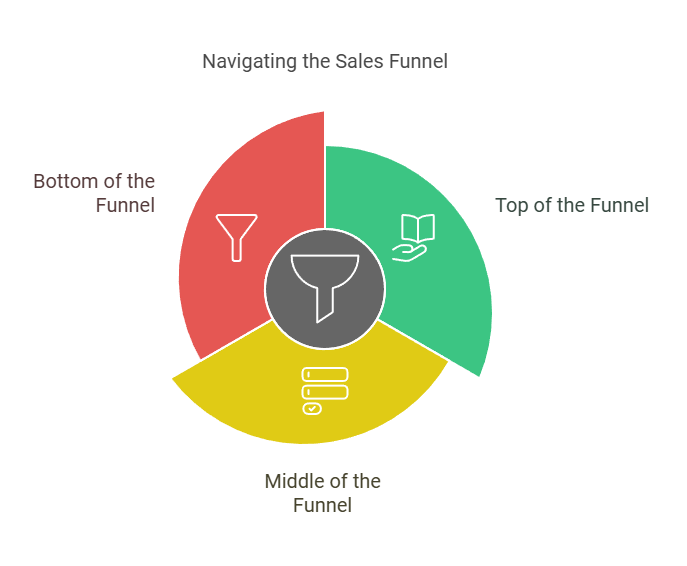
Wrapping Up the Sales Funnel Framework
Understanding the sales funnel allows B2B SaaS companies to create a structured path for guiding leads through their journey. By recognizing the distinct needs of prospects at each stage, businesses can craft more impactful strategies, ensuring they deliver the right message at the right time. This focused approach not only builds trust but also drives consistent and measurable growth over time.
2. Identifying Your Ideal Customer Profile (ICP)
Finding the Perfect Fit with Your Ideal Customer Profile
Identifying the ideal customer profile (ICP) is a foundational step for any B2B SaaS lead generation strategy. Without clarity on who the product is designed to serve, marketing efforts can become too broad, leading to wasted resources and missed opportunities. Defining the ICP allows companies to focus on the prospects most likely to benefit from their offering and become long-term customers.
Understanding What an Ideal Customer Profile Looks Like
An ICP is a detailed description of the type of company that would benefit the most from your SaaS solution. This isn’t about individual buyers; it’s about the organizations that align with your product’s value proposition. Factors such as company size, industry, annual revenue, geographic location, and technology usage play a crucial role in shaping this profile.
For example, a SaaS company offering project management software might find its ICP in mid-sized marketing agencies with teams spread across multiple locations. These organizations likely face challenges in coordinating workflows, making them an ideal fit for a collaborative tool.
How to Define Your Ideal Customer Profile
The process of defining an ICP involves gathering data, analyzing patterns, and refining the details to ensure accuracy. Businesses can start with the following steps:
- Examine Existing Customers: Analyze current customers to identify patterns among those who achieve the most success with the product. Look at metrics such as customer retention rates, product usage, and feedback.
- Leverage Market Research: Use industry reports, surveys, and competitor analysis to understand broader market trends and identify opportunities.
- Engage with Customers Directly: Conduct interviews or send surveys to gather qualitative insights into what customers value most about your product.
- Collaborate Across Teams: Sales, marketing, and customer success teams often have unique perspectives on what makes a customer successful. Pooling this knowledge helps create a more holistic profile.
The Benefits of a Well-Defined ICP
A clearly defined ICP provides several advantages that directly impact lead generation efforts:
- Higher Quality Leads: By targeting organizations that match your ICP, marketing campaigns can attract leads that are more likely to convert into paying customers.
- Improved Resource Allocation: Focusing on the right audience ensures that time, budget, and effort are spent on opportunities with the highest potential for success.
- Better Alignment Between Teams: With a shared understanding of the ideal customer, marketing and sales teams can collaborate more effectively.
Practical Tools for Creating and Using an ICP
| Feature | HubSpot | Salesforce | Zoho CRM |
|---|
| Segmentation | Advanced segmentation with customizable filters and dynamic lists. | Robust segmentation capabilities with detailed criteria and advanced rules. | Customizable segmentation with predefined filters and tags for lead categorization. |
| Data Analytics | Built-in analytics dashboards for customer behavior, engagement metrics, and predictive insights. | Comprehensive analytics with customizable dashboards and AI-powered insights (Einstein Analytics). | Visual analytics dashboards with trend analysis, lead tracking, and KPIs. |
| Reporting | Pre-built and customizable reports, including lead scoring, conversion rates, and campaign performance. | Highly detailed reporting with industry-specific templates and custom report builder. | Flexible reporting tools with options for scheduled reports and custom data exports. |
| Ease of Use | Intuitive interface with minimal setup required; ideal for small to mid-sized teams. | Steeper learning curve; suited for large-scale, enterprise-level operations. | User-friendly with a focus on small to mid-sized businesses; easy to customize. |
| Integration | Extensive integrations with marketing, sales, and automation tools (e.g., Slack, Mailchimp, Shopify). | Seamless integration with a wide range of apps, including ERP systems and third-party platforms. | Integrates with Zoho’s ecosystem (Zoho Books, Zoho Campaigns) and external apps like Zapier and Google Workspace. |
| Pricing | Free plan available; paid plans start at $45/month per user. | Pricing starts at $25/month per user for basic plans, scaling with advanced features. | Free plan available; paid plans start at $14/month per user, making it budget-friendly. |
| Best For | Small to medium businesses seeking an all-in-one solution. | Enterprise-level organizations with complex workflows and large teams. | Small to mid-sized businesses looking for affordable, scalable solutions. |
These tools can help SaaS businesses segment leads, analyze data, and refine their ICP as market conditions evolve.
Making Adjustments to Fit Changing Needs
As markets shift and new trends emerge, the ideal customer profile should be revisited regularly. Businesses that continuously analyze and adapt their ICP will be better positioned to capitalize on new opportunities and stay competitive.
By defining and refining an ICP, B2B SaaS companies can create targeted strategies that resonate with the right audience, driving more meaningful interactions and stronger results.
3. Proven B2B SaaS Lead Generation Strategies
Lead generation is a core challenge for B2B SaaS companies, especially given the competitive landscape and the complexity of the buying journey. Successful strategies often blend creativity with data-driven insights to attract, engage, and convert high-quality leads. Below are proven approaches that consistently deliver results for B2B SaaS organizations.
Establishing Thought Leadership with Content Marketing
Content marketing is a cornerstone of lead generation for B2B SaaS businesses. By providing valuable and educational resources, companies can establish themselves as trusted authorities while addressing the pain points of their target audience.
- Blog Articles: High-quality blog content helps capture organic search traffic and engages readers with actionable insights. Articles should address common challenges faced by the audience, such as optimizing workflows or scaling operations with SaaS tools.
- Case Studies: Sharing real-world success stories demonstrates the value of your solution and builds credibility. Highlight measurable results and industry-specific applications.
- Whitepapers and Ebooks: These long-form resources are ideal for generating leads through gated content. By offering in-depth analysis or step-by-step guides, businesses can attract prospects willing to exchange their contact information for valuable insights.
- Video Tutorials and Demos: Short, engaging videos that explain how your product solves specific problems can drive conversions and improve user understanding.
Improving Visibility with Search Engine Optimization
SEO remains one of the most effective ways to reach potential customers actively searching for solutions. An optimized website ensures higher rankings, increased visibility, and a steady stream of organic traffic.
- Keyword Optimization: Focus on long-tail keywords that reflect buyer intent. For example, “best project management software for remote teams” targets a specific need.
- Technical SEO Enhancements: Improve site speed, mobile compatibility, and crawlability to enhance the user experience and boost rankings.
- Link Building: Earn backlinks from reputable industry websites to establish domain authority and drive referral traffic.
Building Relationships with Email Marketing
Email marketing is a powerful channel for nurturing leads and maintaining relationships with prospects. With proper segmentation and personalization, SaaS businesses can deliver tailored messages that resonate with recipients.
- Drip Campaigns: Create automated sequences that provide value at every stage of the sales funnel. For instance, start with educational resources, followed by product comparisons, and end with an invitation to book a demo.
- Newsletter Campaigns: Keep subscribers informed with updates, success stories, and insights that add value over time.
- Re-Engagement Emails: Target leads who have gone cold with fresh offers, exclusive discounts, or new resources tailored to their interests.
Maximizing Outreach with Social Media Platforms
Social media platforms offer unique opportunities to connect with decision-makers and influencers in your target market. By using a mix of organic content and paid advertising, SaaS companies can expand their reach and engage with potential customers.
- LinkedIn Marketing: Utilize LinkedIn for direct outreach, sponsored posts, and organic content sharing. It’s an ideal platform for B2B marketing due to its professional audience.
- Twitter and Facebook Engagement: Share updates, blogs, and success stories to attract followers and foster community engagement.
- Paid Social Campaigns: Leverage platform-specific targeting features to reach audiences based on industry, job title, or behavior.
Generating Immediate Interest with Pay-Per-Click Advertising
PPC campaigns are particularly effective for capturing high-intent leads. These campaigns can target specific keywords, demographics, and even behaviors to maximize ROI.
- Google Ads: Bidding on relevant keywords ensures your SaaS solution appears at the top of search results, capturing prospects at critical decision points.
- Retargeting Ads: Re-engage visitors who showed interest but didn’t convert. Retargeting ads can encourage them to return and take action.
- Landing Page Design: Ensure that landing pages tied to ad campaigns are focused, visually appealing, and optimized for conversions. Use clear calls to action and eliminate unnecessary distractions.
Engaging with Prospects Through Webinars and Virtual Events
Webinars and virtual events provide a platform to connect with leads while showcasing expertise. These events can be particularly effective in fostering trust and encouraging engagement.
- Educational Sessions: Host webinars that address common industry challenges, providing solutions without overtly pitching your product.
- Interactive Q&A: Encourage attendees to ask questions during or after the event to deepen engagement and build credibility.
- Follow-Up Campaigns: After the event, nurture leads with personalized emails or exclusive offers that encourage the next step.
Encouraging Action with Free Trials and Freemium Models
Product-led growth strategies, such as free trials and freemium models, allow prospects to experience the value of your SaaS solution firsthand.
- Seamless Onboarding: Provide clear instructions and dedicated support to help users get the most out of their trial period.
- Usage Insights: Use analytics to understand how trial users are interacting with your product, and tailor outreach accordingly.
- Upgrade Campaigns: Highlight the benefits of premium features and offer limited-time incentives to encourage upgrades.
Collaborating for Success with Partnerships and Affiliates
Strategic collaborations can open doors to new audiences and drive high-quality leads.
- Affiliate Marketing: Work with trusted partners to promote your SaaS solution in exchange for a commission. Affiliates often have access to niche audiences that align with your ICP.
- Co-Branding Opportunities: Collaborate with complementary businesses to create joint content, webinars, or events that benefit both parties.
- Channel Partnerships: Establish reseller or distribution agreements with companies that can introduce your product to their networks.
This table provides a quick overview to help businesses evaluate and implement lead generation strategies based on their goals, challenges, and available resources.
| Strategy | Benefits | Challenges | Best Practices |
|---|---|---|---|
| Content Marketing | – Builds authority and trust. – Attracts organic traffic over time. – Supports lead nurturing. | – Requires consistent effort and time investment. – Measuring ROI can be complex. | – Focus on high-quality, audience-specific content. – Use gated content (e.g., whitepapers) to capture leads. – Update and optimize content regularly. |
| SEO | – Drives high-quality organic traffic. – Long-term cost efficiency. – Enhances online visibility. | – Results take time to materialize. – Requires technical expertise. | – Conduct thorough keyword research. – Optimize on-page and technical SEO elements. – Build quality backlinks. |
| Email Marketing | – Direct and personalized communication. – High ROI compared to other strategies. – Automated campaigns save time. | – Risk of emails being marked as spam. – Requires a well-maintained contact list. | – Segment your audience for tailored campaigns. – Use A/B testing for subject lines and content. – Optimize for mobile devices. |
| PPC Advertising | – Immediate results with targeted ads. – Scalable with flexible budgets. – Effective for high-intent keywords. | – Can become expensive without proper management. – High competition for certain keywords. | – Focus on precise audience targeting. – Regularly monitor and adjust campaigns. – Optimize landing pages for conversions. |
4. Leveraging Technology for Lead Generation
How Technology Can Transform Lead Generation for B2B SaaS Companies
Technology plays a critical role in elevating lead generation efforts for B2B SaaS businesses. With the right tools and strategies, companies can streamline their processes, better understand their prospects, and ultimately generate more high-quality leads. From CRMs to AI-driven analytics, leveraging technology effectively can make the difference between good results and exceptional growth.
Staying Organized and Productive with CRM Systems
Customer relationship management systems are essential for managing the complexities of lead generation. These platforms help businesses track every interaction, ensuring nothing falls through the cracks.
- Lead Tracking: CRMs provide a clear view of where each prospect is in the sales funnel. This visibility allows teams to prioritize efforts on leads that are closer to conversion.
- Segmentation: By categorizing leads based on factors like industry, size, or behavior, CRMs ensure marketing campaigns are highly targeted and relevant.
- Data-Driven Decision Making: Metrics such as conversion rates, pipeline value, and deal velocity are available at a glance, enabling businesses to refine their strategies.
Popular CRMs like Salesforce, HubSpot, and Pipedrive offer advanced features like automation, analytics, and integrations with other tools, making them a cornerstone for any SaaS lead generation strategy.
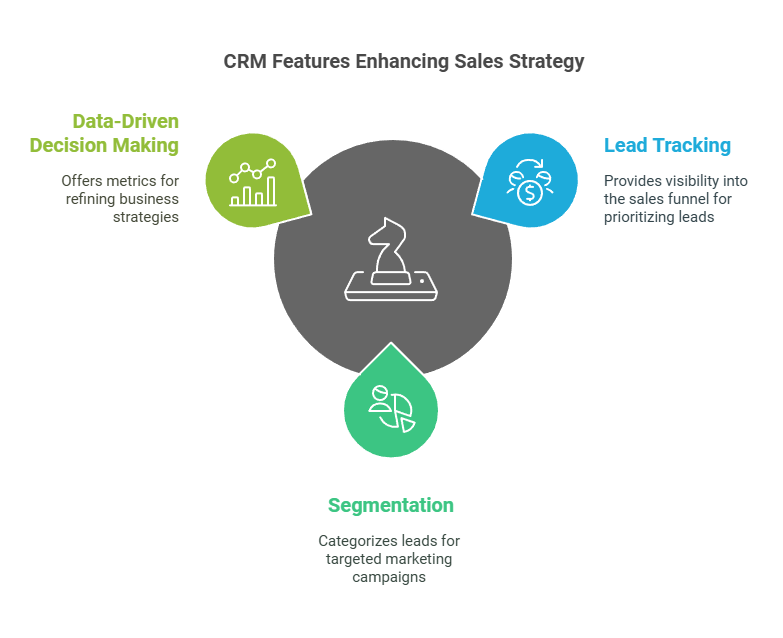
Scaling Efforts with Marketing Automation
Marketing automation tools simplify and enhance lead generation by handling repetitive tasks while maintaining a personalized touch. These platforms allow businesses to manage large-scale campaigns without sacrificing relevance.
- Automated Campaigns: From welcome sequences to nurture emails, automation ensures leads receive timely and personalized communication.
- Lead Scoring: By assigning scores based on engagement, behavior, or demographics, automation tools help teams focus on leads most likely to convert.
- Cross-Channel Campaigns: Platforms like Marketo and Pardot enable SaaS companies to execute coordinated campaigns across email, social media, and ads, all from a single dashboard.
Automation not only saves time but also ensures consistency, helping businesses stay top-of-mind for potential customers.
Engaging Visitors with AI-Powered Chatbots
AI-powered chatbots and virtual assistants are becoming indispensable for SaaS companies looking to engage leads in real time. These tools provide immediate responses, improving the customer experience while freeing up human resources for more complex tasks.
- Lead Qualification: Chatbots can ask pre-defined questions to assess a prospect’s needs and readiness to purchase, qualifying leads on the spot.
- 24/7 Availability: Unlike human agents, chatbots can operate around the clock, capturing leads outside of business hours.
- Personalized Interactions: By analyzing visitor behavior, AI chatbots can offer relevant suggestions or guide users to specific resources.
Popular chatbot tools like Drift and Intercom integrate seamlessly with CRMs, ensuring that the data collected is actionable and easily accessible.
Using Predictive Analytics for Smarter Targeting
Predictive analytics, powered by artificial intelligence, allows businesses to forecast lead behavior and tailor their outreach strategies. By analyzing past data, these tools provide actionable insights that can significantly improve conversion rates.
- Behavior Predictions: Identify which leads are most likely to engage or convert based on historical patterns.
- Content Recommendations: Deliver personalized content to prospects based on their preferences and past interactions.
- Optimized Timing: Predictive tools can determine the best times to send emails or follow up with leads, ensuring maximum engagement.
By incorporating predictive analytics into their lead generation strategy, SaaS businesses can make more informed decisions and allocate resources more effectively.
Integrating Technology for a Seamless Workflow
The effectiveness of technology often depends on how well different tools work together. Integration ensures that data flows smoothly between platforms, creating a cohesive system for managing leads.
- Unified Data Management: Integration allows businesses to combine information from CRMs, email platforms, chatbots, and analytics tools into a single source of truth.
- Custom Triggers: For example, when a lead downloads a whitepaper, the system can automatically assign them a score and send a follow-up email.
- Real-Time Updates: Synchronizing data across tools ensures teams always have the most accurate information at their fingertips.
Tools like Zapier and native integrations offered by CRMs make it easier to connect multiple platforms, improving efficiency and reducing manual work.
Measuring Success with Analytics and Reporting
The ability to track and analyze performance is one of the greatest advantages of using technology in lead generation. Robust analytics ensure that strategies are continuously optimized for better results.
- Campaign Metrics: Monitor key indicators like click-through rates, conversion rates, and cost per lead to evaluate the effectiveness of campaigns.
- A/B Testing: Test different versions of emails, ads, or landing pages to identify what resonates most with your audience.
- Customer Journey Analysis: Understand how prospects move through the funnel and identify any bottlenecks that may be hindering progress.
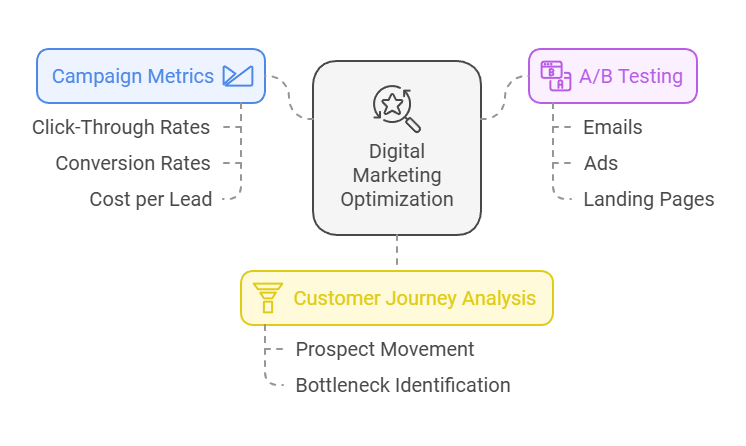
Final Thoughts on Leveraging Technology
Technology is a powerful enabler for B2B SaaS companies looking to enhance their lead generation efforts. By adopting tools like CRMs, automation platforms, and AI-driven analytics, businesses can work smarter, not harder. These solutions not only improve efficiency but also create personalized, data-driven experiences that resonate with prospects and drive meaningful results. For companies willing to invest in the right technology, the rewards can be transformative.
5. Measuring and Optimizing Lead Generation Efforts
In B2B SaaS lead generation, measurement and optimization are not just important—they are essential. Without a clear understanding of what is working and what needs adjustment, businesses risk wasting time and resources on ineffective strategies. By focusing on key metrics, leveraging testing, and refining approaches based on data, companies can ensure their lead generation efforts consistently deliver value.
Identifying the Metrics That Matter Most
Choosing the right metrics is the foundation of effective measurement. While there are countless data points available, focusing on the ones that align with business goals is crucial:
1. Lead Conversion Rate
Definition:
The percentage of leads that move from one stage of the sales funnel to the next. This metric reflects how effectively your messaging and targeting resonate with the audience.
Why It Matters:
A high conversion rate indicates that your campaigns are successfully addressing the needs and concerns of your target audience.
How to Calculate:

Best Practices:
- Personalize communication to align with the lead’s stage in the funnel.
- Use A/B testing to refine messaging and calls to action (CTAs).
- Offer value-driven content, such as case studies or demos, to motivate action.
2. Cost Per Lead (CPL)
Definition:
The total cost of generating a lead. This metric helps businesses assess the efficiency of their campaigns and allocate budgets to high-performing channels.
Why It Matters:
Understanding CPL allows businesses to compare the cost-effectiveness of different lead generation channels.
How to Calculate:

Best Practices:
- Focus on channels that deliver high-quality leads at a lower cost.
- Optimize ad spend by targeting specific demographics or behaviors.
- Continuously monitor campaigns and reallocate budgets to better-performing efforts.
3. Customer Acquisition Cost (CAC)
Definition:
CAC measures the total cost of acquiring a new customer, factoring in both marketing and sales expenses.
Why It Matters:
This metric provides a comprehensive view of efficiency. A low CAC paired with a high conversion rate is a clear sign of an optimized strategy.
How to Calculate:

Best Practices:
- Automate repetitive tasks to reduce operational costs.
- Align marketing and sales teams to improve collaboration and efficiency.
- Use data-driven insights to target higher-quality leads.
4. Lead Velocity Rate (LVR)
Definition:
The rate at which qualified leads are growing over a specific time period. LVR is a forward-looking metric that helps forecast revenue growth.
Why It Matters:
Tracking LVR ensures businesses have a steady pipeline of potential customers, which is critical for sustained growth.
How to Calculate: LVR=

Best Practices:
- Use predictive analytics to identify trends and adjust strategies proactively.
- Focus on lead nurturing to maintain engagement over time.
- Monitor growth consistently to avoid pipeline stagnation.
5. Engagement Metrics
Definition:
Metrics like email open rates, click-through rates (CTR), and time spent on site measure how well your campaigns are engaging the target audience.
Why It Matters:
High engagement indicates that your content and communication efforts are resonating with leads, increasing the likelihood of conversion.
Key Metrics to Track:
- Email Open Rate: Percentage of recipients who open your email.
- Click-Through Rate (CTR): Percentage of recipients who click on a link within your email.
- Time on Site: Average duration a visitor spends on your website.
Best Practices:
- Create compelling subject lines and CTAs to boost email performance.
- Optimize website design and content for an engaging user experience.
- Use interactive elements like videos and polls to maintain attention.
Comparison Table of Metrics
| Metric | Definition | Importance | How to Improve |
|---|---|---|---|
| Lead Conversion Rate | Percentage of leads advancing in the funnel. | Reflects the effectiveness of messaging and targeting. | Personalize communication and use A/B testing. |
| Cost Per Lead (CPL) | Cost of generating a lead. | Assesses campaign cost-efficiency. | Focus on high-performing channels and optimize targeting. |
| Customer Acquisition Cost (CAC) | Total cost of acquiring a new customer. | Measures overall efficiency of lead generation. | Align marketing and sales efforts, automate workflows. |
| Lead Velocity Rate (LVR) | Growth rate of qualified leads over time. | Helps forecast potential revenue growth. | Monitor trends and focus on lead nurturing. |
| Engagement Metrics | Includes email open rates, CTR, and time on site. | Indicates campaign engagement levels. | Use compelling CTAs, optimize content, and engage with interactive elements. |
Implementing A/B Testing to Find What Works
Testing is one of the most effective ways to identify areas for improvement. A/B testing allows businesses to compare two versions of a campaign element to see which performs better.
- Landing Pages: Experiment with different headlines, layouts, or calls to action to identify the version that generates the most conversions.
- Email Campaigns: Test subject lines, content formats, or send times to optimize engagement and responses.
- Ad Variations: Compare visuals, messaging, or targeting options to determine what resonates best with the audience.
The key to successful A/B testing is to change one variable at a time while maintaining consistency in all other aspects. This approach ensures accurate results and actionable insights.
Using Feedback to Refine Strategies
Customer and team feedback provide invaluable insights into what is and isn’t working. By actively seeking input from various sources, businesses can uncover blind spots and refine their strategies.
- Customer Feedback: Surveys, interviews, and direct feedback from leads and clients can reveal gaps in messaging, product alignment, or pain point identification.
- Sales Team Insights: Sales teams are often closest to the leads and can provide real-world perspectives on the effectiveness of campaigns and messaging.
- Competitor Analysis: Studying what competitors are doing can uncover opportunities or highlight areas where strategies need to be adjusted.
Automating Data Collection and Analysis
Manual data tracking can be time-consuming and prone to error. Automation tools simplify this process by collecting, organizing, and analyzing data in real time.
- CRM Dashboards: Tools like Salesforce and HubSpot offer customizable dashboards that provide a comprehensive view of lead generation metrics.
- Analytics Platforms: Google Analytics, for example, tracks website performance, while email platforms like Mailchimp provide detailed campaign analytics.
- Integrations: Connecting tools ensures that data flows seamlessly between platforms, creating a unified system for monitoring and reporting.
Automation not only saves time but also ensures that teams can focus on interpreting data rather than collecting it.
Making Continuous Optimization a Priority
Optimization is not a one-time activity; it’s an ongoing process. Markets evolve, buyer behaviors shift, and what works today might not work tomorrow. Regularly reviewing performance and making adjustments ensures that strategies stay relevant and effective.
- Monthly Performance Reviews: Schedule regular reviews to analyze metrics, identify trends, and discuss areas for improvement.
- Iterative Changes: Small, incremental adjustments based on data can have a cumulative impact on overall performance.
- Staying Updated: Keep track of industry trends and technology advancements to identify new opportunities for optimization.

Final Thoughts on Measuring and Optimizing Lead Generation
Measuring and optimizing lead generation efforts is not just about tracking numbers—it’s about understanding what drives results and continuously improving. By focusing on meaningful metrics, leveraging testing, and incorporating feedback, B2B SaaS companies can ensure that their strategies remain effective in a competitive market. With a commitment to data-driven decision-making, businesses can achieve sustained growth and success in their lead generation efforts.
6. Navigating Challenges in B2B SaaS Lead Generation
Overcoming Common Challenges in B2B SaaS Lead Generation
Generating leads in the B2B SaaS landscape comes with its own set of hurdles. The complex buyer journey, long sales cycles, and the need to appeal to multiple decision-makers often make the process more challenging than in other industries. However, with the right strategies and tools, these obstacles can be turned into opportunities for growth. Here’s a closer look at the most common challenges and how businesses can navigate them effectively.
Dealing with Long Sales Cycles
The extended time frame of B2B SaaS sales cycles is one of the biggest challenges. With multiple stakeholders involved and a higher investment at stake, prospects take longer to evaluate and decide.
- Nurturing Leads Over Time: Businesses should implement long-term nurture campaigns that keep leads engaged throughout the cycle. Drip email campaigns, regular newsletters, and value-driven content help maintain interest.
- Multi-Touch Attribution: Use tools to track all touchpoints during the buyer journey, helping to understand what drives decisions and where to focus efforts.
- Demonstrating ROI Early: Sharing case studies, ROI calculators, and product benefits upfront can accelerate decision-making by providing tangible value.
Navigating Multiple Decision-Makers
In B2B SaaS, purchasing decisions often involve an entire team rather than a single individual. Each stakeholder may have different priorities, adding complexity to the process.
- Account-Based Marketing (ABM): ABM allows businesses to create tailored campaigns for specific accounts, addressing the unique needs of each decision-maker within the organization.
- Personalized Messaging: Craft messages that speak directly to the concerns of different stakeholders—technical teams may focus on product features, while executives prioritize ROI.
- Stakeholder Mapping: Identify all influencers and decision-makers early, ensuring that your strategy addresses their unique perspectives and pain points.
Standing Out in a Saturated Market
With thousands of SaaS companies competing for attention, differentiation is critical. A lack of clear value propositions can make it difficult to capture and retain interest.
- Highlighting Unique Selling Points (USPs): Focus on what sets your product apart. Whether it’s superior customer support, advanced features, or pricing flexibility, make these advantages clear.
- Investing in Branding: A strong brand builds trust and makes your product more memorable. Consistent visuals, tone of voice, and messaging reinforce credibility.
- Content that Resonates: Share thought leadership pieces, industry insights, and success stories that showcase your expertise and build trust.
Managing the Complexity of Data-Driven Strategies
Effective lead generation relies on data, but managing and interpreting large volumes of information can be overwhelming.
- Centralizing Data Management: Use tools like CRMs or data integration platforms to consolidate information in one place. This ensures consistency and reduces errors.
- Simplifying Analytics: Focus on key metrics that align with business goals rather than getting lost in unnecessary details. Tools like Google Analytics, HubSpot, or Tableau can help visualize data for better decision-making.
- Automation for Efficiency: Automate repetitive tasks like lead scoring, segmentation, and campaign reporting to save time and reduce human error.
Addressing Privacy Concerns and Regulatory Compliance
As data privacy regulations become stricter, businesses must ensure their lead generation efforts comply with laws like GDPR, CCPA, and others.
- Transparent Data Practices: Be upfront about how you collect, store, and use data. Include clear privacy policies and obtain explicit consent when required.
- First-Party Data Strategies: Focus on collecting data directly from prospects through gated content, webinars, and sign-ups, reducing reliance on third-party sources.
- Regular Compliance Audits: Conduct routine checks to ensure all marketing efforts meet regulatory standards and avoid potential penalties.
Retaining Leads Through Effective Follow-Up
Leads that aren’t followed up with effectively can quickly lose interest, especially in competitive markets.
- Timely Responses: Use automation or chatbots to respond to inquiries immediately, reducing the risk of prospects moving to competitors.
- Personalized Outreach: Tailor follow-up communication to reflect the prospect’s specific needs, highlighting how your solution addresses their challenges.
- Consistent Touchpoints: Stay engaged with leads through multiple channels, such as emails, phone calls, and social media, to maintain top-of-mind awareness.
Leveraging Collaboration for Greater Reach
Collaborating with partners or affiliates can open up new lead generation opportunities but also requires careful planning to succeed.
- Co-Marketing Campaigns: Partner with complementary businesses to host joint webinars, create content, or share audiences.
- Affiliate Programs: Incentivize partners to promote your product in exchange for commissions, expanding your reach without direct marketing costs.
- Clear Communication: Ensure all partners are aligned on goals, messaging, and deliverables to maximize the effectiveness of collaborations.
Final Thoughts on Navigating Challenges
Challenges in B2B SaaS lead generation are inevitable, but they’re also opportunities to refine strategies and stand out in a competitive market. By addressing long sales cycles, engaging multiple decision-makers, and leveraging data effectively, businesses can overcome these obstacles and build a robust pipeline. With the right tools, clear messaging, and a focus on personalization, even the most complex challenges can lead to success.
7. Future Trends in B2B SaaS Lead Generation
The landscape of B2B SaaS lead generation is evolving rapidly, driven by advancements in technology, shifts in buyer behavior, and the growing demand for personalization. Staying ahead of these trends is critical for businesses looking to maintain a competitive edge. Here’s a look at the future trends poised to redefine how SaaS companies generate and nurture leads.
The Growing Role of Artificial Intelligence and Machine Learning
AI and machine learning are becoming integral to lead generation strategies, offering new ways to streamline processes and improve decision-making.
- Predictive Lead Scoring: AI tools can analyze past customer data to predict which leads are most likely to convert, enabling sales teams to prioritize efforts more effectively.
- Personalized Content Delivery: Machine learning algorithms can analyze user behavior and preferences to deliver highly relevant content, improving engagement and driving conversions.
- AI-Powered Chatbots: Chatbots equipped with natural language processing are handling more complex queries, qualifying leads, and providing instant responses that improve the customer experience.
Account-Based Experience is Gaining Momentum
Account-based marketing (ABM) is evolving into account-based experience (ABX), emphasizing holistic and highly personalized engagement with target accounts.
- Cross-Channel Personalization: ABX ensures that every interaction, from email to social media to sales calls, feels tailored to the needs of the account.
- Data-Driven Insights: Advanced analytics and intent data are helping businesses identify the right accounts to target and craft strategies that resonate with key decision-makers.
- Collaboration Across Teams: ABX requires marketing, sales, and customer success teams to align their efforts for a seamless and consistent experience.
Interactive and Immersive Content is Driving Engagement
Static content is no longer enough to capture attention in a crowded market. Interactive and immersive content is gaining traction as a way to engage audiences and stand out.
- Interactive Webinars: Webinars with live Q&A sessions, polls, and audience participation are more effective at holding attention and fostering connections.
- Dynamic Landing Pages: Personalized landing pages that adapt to user behavior or preferences offer a more engaging experience.
- Visual Storytelling: Infographics, videos, and interactive data visualizations help simplify complex ideas while keeping prospects engaged.
First-Party Data is Becoming a Priority
With increasing privacy regulations and the decline of third-party cookies, first-party data collection is now a cornerstone of effective lead generation.
- Gated Content Strategies: Ebooks, whitepapers, and webinars remain key tools for collecting contact information directly from prospects.
- Customer Surveys and Feedback: Engaging prospects and customers through surveys not only provides valuable insights but also strengthens relationships.
- CRM Integration: Leveraging CRM systems to organize and analyze first-party data ensures businesses can act on insights quickly and effectively.
The Rise of Video as a Lead Generation Tool
Video content is taking center stage as an effective way to connect with B2B audiences, explain complex products, and build trust.
- Product Demonstrations: Short, high-quality videos that showcase key features and benefits can help prospects understand the value of the product.
- Customer Testimonials: Video testimonials from satisfied customers provide social proof and build credibility.
- Live Streams and Events: Platforms like LinkedIn Live enable real-time interaction with prospects, fostering a sense of connection and immediacy.
Sustainability and Social Responsibility are Influencing Buyer Decisions
B2B buyers are increasingly considering the values and ethics of the companies they do business with. Demonstrating a commitment to sustainability and social responsibility is becoming an important differentiator.
- Transparent Practices: Highlighting initiatives like carbon-neutral operations or ethical sourcing can resonate with value-driven prospects.
- Cause-Based Campaigns: Collaborating with non-profits or promoting social causes can strengthen brand loyalty and attract like-minded businesses.
Automation and Integration are Streamlining Processes
The integration of various tools and platforms is simplifying workflows, reducing redundancies, and making it easier to execute lead generation strategies at scale.
- End-to-End Platforms: All-in-one solutions that combine CRM, email marketing, analytics, and automation are gaining popularity for their ease of use.
- API Integrations: Custom integrations between tools ensure data flows seamlessly, enabling real-time insights and smoother collaboration across teams.
- Workflows with Triggers: Automation platforms like Zapier are enabling trigger-based workflows, such as sending follow-up emails after form submissions or updating CRM records automatically.
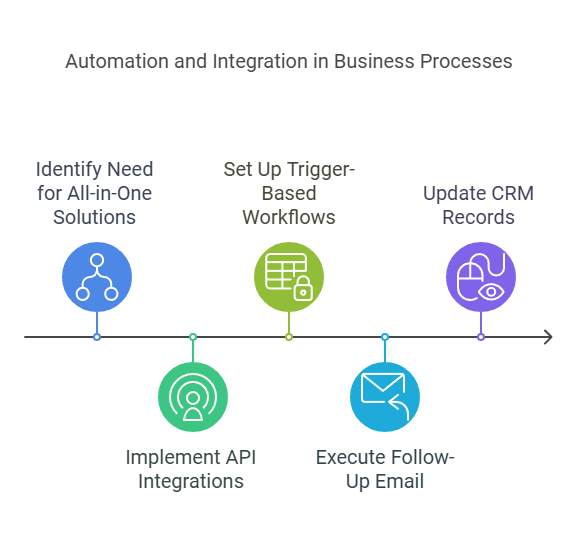
Preparing for What’s Next in Lead Generation
The future of B2B SaaS lead generation lies in personalization, technology, and a commitment to understanding evolving buyer needs. By adopting these trends and staying adaptable, SaaS companies can position themselves for long-term success. Businesses that prioritize innovation and focus on building meaningful connections with prospects will be best equipped to navigate the changing landscape and thrive in the years to come.
8. Conclusion
Tying It All Together for Better B2B SaaS Lead Generation
Effective lead generation for B2B SaaS companies requires a careful balance of strategy, technology, and adaptability. With a clear understanding of the sales funnel, a well-defined ideal customer profile, and the integration of cutting-edge tools, businesses can build a pipeline that delivers both quantity and quality. The key is to approach lead generation as an ongoing process, continuously optimizing efforts to stay ahead in a competitive market.
Recap of Key Strategies
Throughout the process, there are several foundational elements that ensure success in lead generation. These include understanding the sales funnel, leveraging content marketing, and implementing technology to automate and enhance processes.
- The Sales Funnel: Tailoring strategies to the different stages of the funnel ensures that leads are nurtured effectively. The focus on awareness, consideration, and decision-making helps move prospects seamlessly through the buyer’s journey.
- Content Marketing: High-quality content, such as blog posts, case studies, and whitepapers, builds credibility and attracts the right audience. Interactive formats like webinars and videos further engage leads and encourage action.
- Technology Integration: Tools like CRMs, automation platforms, and AI-driven analytics are essential for managing data, optimizing campaigns, and improving efficiency.
Actionable Next Steps
Businesses looking to enhance their lead generation efforts should focus on actionable steps that align with their unique goals and resources.
- Audit Existing Strategies: Regularly review current campaigns to identify gaps and areas for improvement. This includes analyzing metrics such as cost per lead, conversion rates, and customer acquisition cost.
- Refine the Ideal Customer Profile: Continuously update the ICP based on data from successful deals, feedback, and market trends. A clear profile ensures that marketing efforts target the right audience.
- Invest in Training and Collaboration: Aligning marketing, sales, and customer success teams through training and shared goals enhances communication and ensures consistent messaging across all touchpoints.
- Adopt New Tools Thoughtfully: Stay informed about emerging technologies and invest in tools that align with specific business needs. Whether it’s implementing AI-powered chatbots or expanding automation capabilities, choose solutions that provide clear value.
The Importance of Consistency and Adaptability
Consistency is critical in lead generation, but it should never come at the expense of flexibility. The ability to adapt to market changes, buyer behaviors, and technological advancements is what separates successful companies from those that struggle to stay competitive.
- Stay Current on Trends: Regularly monitor industry developments, buyer expectations, and regulatory changes to ensure strategies remain relevant.
- Test and Learn: A/B testing campaigns, experimenting with new formats, and analyzing results help identify what works and where improvements can be made.
- Iterative Improvements: Small, consistent updates based on data and feedback create a cycle of ongoing optimization, ensuring efforts remain effective over time.
Encouraging a Long-Term Perspective
Lead generation is not a one-time effort—it’s a long-term investment in building relationships and creating value. Businesses that take a strategic approach to nurturing leads and focus on delivering exceptional experiences will see sustained success.
- Build Trust: Transparency in communication, ethical data practices, and delivering on promises all contribute to fostering trust with prospects and clients.
- Measure Impact Beyond Immediate Gains: While short-term metrics like lead volume and conversion rates are important, consider the broader impact on brand reputation, customer lifetime value, and market positioning.
- Scale Intelligently: As lead generation strategies gain traction, scale efforts in a way that maintains quality and efficiency. Automation and technology play a key role in enabling scalability without losing the personal touch.
Final Takeaway
B2B SaaS lead generation is as much about understanding the target audience as it is about deploying the right tools and tactics. Businesses that take the time to refine their approach, invest in the right resources, and commit to continuous improvement will find themselves well-positioned to thrive in an increasingly competitive landscape. By focusing on creating meaningful connections and delivering real value, SaaS companies can not only generate leads but also build lasting relationships that drive long-term growth.
